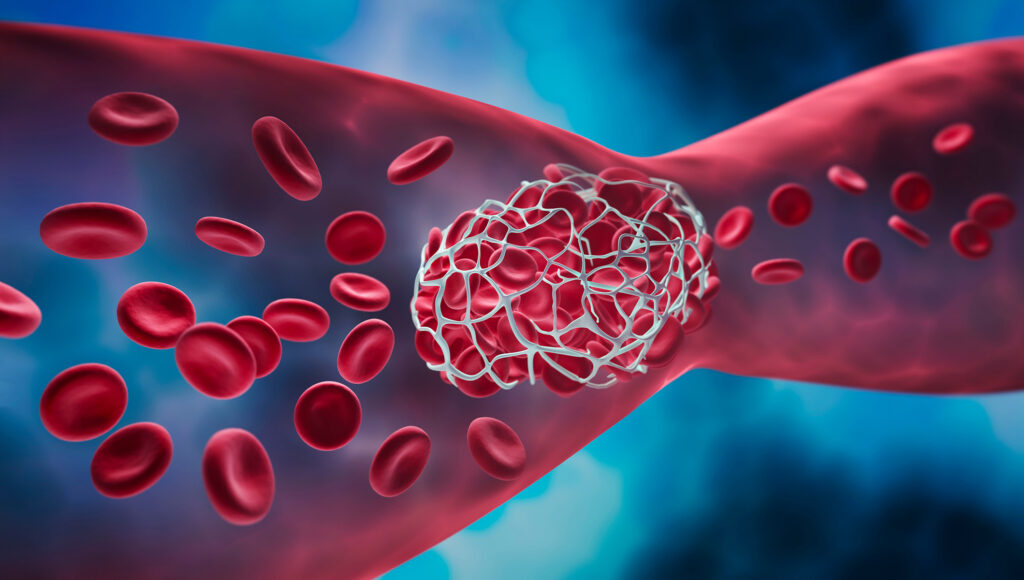Combined Pediatric-Adult Anticoagulation Program Exceeds Goals
Combined Pediatric-Adult Anticoagulation Program Exceeds Goals https://pediatricsnationwide.org/wp-content/uploads/2023/10/AdobeStock_446278183-clot-1024x580.jpg 1024 580 Mary Bates, PhD Mary Bates, PhD https://secure.gravatar.com/avatar/c6233ca2b7754ab7c4c820e14eb518c8?s=96&d=mm&r=g- October 13, 2023
- Mary Bates, PhD

The program achieved excellent quality of anticoagulation therapy in children and adults.
The goal of most anticoagulation programs is to improve the care of adult patients on warfarin therapy, specifically by treating and preventing thromboembolic events while minimizing bleeding risk. In a new study, researchers from Nationwide Children’s Hospital report excellent outcomes for a combined pediatric and adult anticoagulation program, and credit multidisciplinary teamwork and integrated practices.
The combined pediatric-adult anticoagulation program at Nationwide Children’s was established in 2014. The program provides care to both adults and children on long-term warfarin therapy, in addition to a smaller group of patients on short-term warfarin therapy or other anticoagulants. While most other programs serve adult patients living near the host hospital, the program at Nationwide Children’s serves adult and pediatric patients across the state of Ohio. The team is made up of physicians, nurse practitioners, and registered nurses who serve as clinician nurse coordinators, as well as collaborators in hematology, laboratory medicine, pharmacy, cardiology and other subspecialties.
For the new study, researchers reviewed patient medical records from 2014 to 2019 to compare the quality of anticoagulation therapy before and after implementation of the program (as measured by percent of time spent in the therapeutic range (%TTR) and compliance). They also assessed bleeding and thrombotic complications.
Overall, the findings demonstrate that a multidisciplinary team using an integrated approach can help diverse patients achieve high-quality anticoagulant therapy, says lead author Vilmarie Rodriguez, MD, a pediatric hematologist and director of the thrombosis and anticoagulation program.
Post-program implementation, patients achieved a median %TTR of 78.9%, easily exceeding the minimum 60% target previously proposed as an acceptable measure of anticoagulation therapy quality for adults. Compliance, measured as at least one international normalized ratio (INR) blood test per month per patient, also increased following program implementation by 34.3% (50% vs. 84.3%, pre- vs. post-, respectively).
Dr. Rodriguez and colleagues found that these high %TTR and compliance rates were sustained during the study period, resulting in relatively low bleeding and thrombotic events. In addition, there was no association between bleeding and thrombotic events and %TTR, likely due to the high median %TTR achieved by this approach.
“We did not find a difference in the quality of anticoagulant care between the adult and pediatric patients,” says Dr. Rodriguez. “This shows that our anticoagulation program team is able to provide equal, excellent care for adults and children across a wide geographic area using this approach.”
Dr. Rodriguez and colleagues say much of this success is a result of the integrated, multidisciplinary nature of the program.
“Every member of the team is invested in providing the best care for our patients, whether they are on short-term or long-term anticoagulation,” says Dr. Rodriguez. “I think the impressive volume and complexity of patient care we provide, and the very good outcomes we achieve, ultimately result from teamwork and collaboration.”
This article also appears in the Fall/winter 2023 print issue. Download the full issue.
Reference:
Rodriguez V, Stanek J, Cua CL, Sankar A, Giver J, Monda K, Canini J, Dunn AL, Kerlin BA. A regional anticoagulation program improves safety and outcomes for both children and adults. Journal of Thrombosis and Thrombolysis. 2023 Apr 24. [Epub ahead of print] DOI: 10.1055/s-0036-1597762
Image credit: Adobe Stock
About the author
Mary a freelance science writer and blogger based in Boston. Her favorite topics include biology, psychology, neuroscience, ecology, and animal behavior. She has a BA in Biology-Psychology with a minor in English from Skidmore College in Saratoga Springs, NY, and a PhD from Brown University, where she researched bat echolocation and bullfrog chorusing.
-
Mary Bates, PhDhttps://pediatricsnationwide.org/author/mary-bates-phd/December 27, 2016
-
Mary Bates, PhDhttps://pediatricsnationwide.org/author/mary-bates-phd/
-
Mary Bates, PhDhttps://pediatricsnationwide.org/author/mary-bates-phd/
-
Mary Bates, PhDhttps://pediatricsnationwide.org/author/mary-bates-phd/
- Posted In:
- Clinical Updates
- In Brief
- Research






